The United States of Film: Illinois
20 movies that capture and define the Land of Lincoln
Movies Lists IllinoisIllinois, if you’ve never heard of it, is the state that contains Chicago.
That’s a somewhat unfair, but undeniably accurate way to define Illinois. Those living in “Southern Illinois,” loosely defined by most Chicagoans as “Anything south of the Chicago burbs,” tend to have a somewhat complicated, contentious relationship with the big city, and to feel underrepresented as a result. It’s true—they are grossly underrepresented in the media and in the arts, especially when it comes to film. Still, around 75 percent of the entire state’s population can be found residing in Chicago’s greater metropolitan area. The obsession is understandable, and it means that a lot of the films to truly capture the Illinois ethos are set in or feature Chicago.
And let’s face it—when it comes to films, the beautiful Chicago skyline has always been a magnet, whether or not the city’s mayor in each generation has been particularly welcoming to Hollywood filmmakers shutting down the streets. This potentially cost a few films a spot on this list—let’s say, something like My Big Fat Greek Wedding, which is proudly set in Chicago’s classic Greektown, but did most of its actual filming in Toronto. Sorry guys, gotta dock you for that. Other films like Mean Girls incidentally take place in Illinois, but were you even aware of that before reading this? Its Illinois location in no way factors into the heart and soul of the film, so it’s not on the list either.
And yes, just so you know, there are indeed some films on the list that don’t take place in Chicago, that manage to capture the ebb and flow of smaller-town Illinois life. These 20 movies, taken as a whole, paint a picture of a vibrant but oftentimes gritty state, full of opportunity but also a twist of danger and corruption. These films can all be found in the shared mythology of my home state.
1. The Dark Knight
Year: 2008
Director: Christopher Nolan

Gotham City is by no means located in Illinois, but everyone knows that in terms of its depiction, Chicago is the true heart and soul of Batman’s hometown. This movie, more than any of the others in the series, just reeks of Chicago, with dozens of iconic locations featured. Indeed, Nolan barely seems interested in disguising all of the landmarks, from putting the headquarters of Wayne Enterprises in the Richard J. Daley Center to staging the Joker car chase sequence on lower Wacker Drive where The Blues Brothers zoomed by on their Bluesmobile 28 years earlier. That’s of course just the beginning: the Sears Tower, Navy Pier, Trump International Hotel and Tower, The Berghoff and Randolph Street Station can all be seen, among others. Although some city residents probably wouldn’t like to admit it, the characterization is appropriate on multiple levels, given the story of vigilantism vs. the city’s history with and connections to organized crime. The connection between Gotham and Chicago goes beyond the visual and dives straight into the gritty heart of a city that has historically often had something insidious bubbling under the surface.
2. The Informant!
Year: 2009
Director: Steven Soderbergh
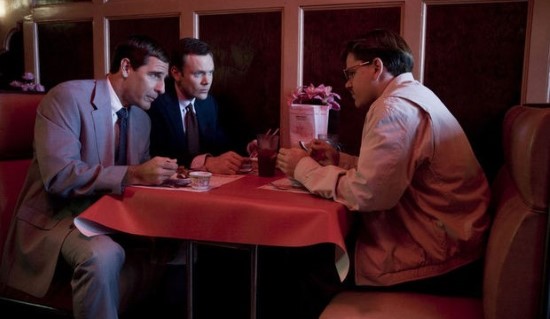
It was pretty much impossible for me to miss this one, given that I spent four years working at the newspaper in Decatur, Ill., where the film takes place. Matt Damon stars as a real-life, decidedly non-movie star white-collar executive named Mark Whitacre who turned FBI informant against his employer, aggro-business giant Archer Daniels Midland, to reveal a price-fixing scandal. Rather than a straight comedy, though, The Informant! is rather a fascinating entry into the mind of a singularly odd man, one who tried to scam the FBI even as he was providing them information and ended up in jail right alongside his bosses. It features plenty of on-location scenes in Decatur, a mid-size, blue-collar city that is indicative of Illinois’ past prominence in the manufacturing industry. It’s a good look into the kinds of cities that dot the interior of Illinois, islands of buildings surrounded by fields of corn and soybeans, where Chicago is all-too-often considered a sort of separate province supposedly populated by the effete bourgeois. And I say this as someone who once attended a press conference where a state legislator introduced a proposal to split Chicago off into the 51st state of the Union so the good and decent folks of Central Illinois could live their own existence.
3. Eight Men Out
Year: 1988
Director: John Sayles
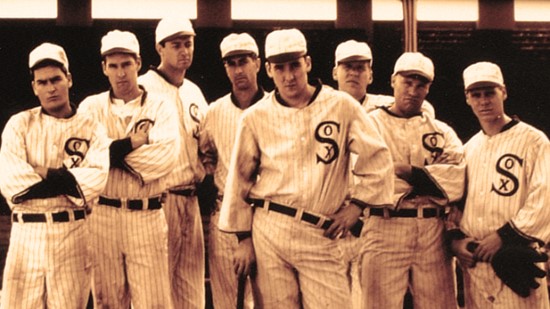
Growing up in the southern Chicago burbs, the White Sox were my MLB team, and the experience of being a ChiSox fan is a crash course in the history of infamy. It’s weird to think of something that happened almost 100 years ago in a team’s history profoundly affecting that team’s identity even to this day, but believe it or not, there are still people in that area who feel passionately about the 1919 “Black Sox” scandal, wherein eight players conspired at different levels to intentionally lose the World Series at the behest of gamblers. The film, based on Eliot Asinof’s classic 1963 book, explores the complex motivations that drove some players knowingly into the ruse, such as pitcher Eddie Cicotte, in rebellion of a pinch-penny team owner, Charles Comiskey, who barely paid his players a living wage. David Strathairn is wonderful as Cicotte, the lynch-pin to the scandal, as is John Cusack as Buck Weaver, the idealistic player who refuses the participate in the fix but still ends up banned for life from baseball anyway. In a city famous for corruption, the Black Sox scandal has always been a dark spot on Chicago’s sporting history, a persistent reminder of the nefarious forces operating in the shadows to undermine even something as pure as the national pastime.
4. A League of Their Own
Year: 1992
Director: Penny Marshall

And just to show that Illinois baseball movies don’t necessarily have to be depressing as hell, A League of Their Own also takes place in the Prairie State. The Rockford Peaches hosted the likes of Geena Davis, Rosie O’Donnell and Madonna in this charming 1992 comedy-drama, today remembered primarily (and understandably) for one of Tom Hanks’ most colorful supporting roles as the team’s alcoholic manager, Jimmy Dugan. The film showcases Illinois as an archetypal Midwestern state during a period of change, especially as far as gender dynamics were concerned. With men such as the husband of Davis’ character away fighting World War II, women were being thrust into the workplace and even the sporting arena in a wave of unexpected, often unwanted progressiveness. The foundations laid in arenas so seemingly insignificant as a baseball stadium had a direct correlation with the rise of second-wave feminism in the 1960s, both in Illinois and the nation as a whole.
5. White Heat
Year: 1949
Director: Raoul Walsh

The trope of the Prohibition-era gangster is more heavily ingrained in Chicago than any other city in the country, to the extent that Chicagoans traveling abroad often find that the first reaction of people on the other side of the world to the phrase “Chicago” is references to Tommy Guns and Al Capone. The criminals who more or less ran the city in the Roaring Twenties have been a fixture of populist imagination ever since, especially in ’30s and ’40s Hollywood, and especially at Warner Bros., which built its fortunes as the “gangster studio” in this period by cranking out dozens and dozens of shoot-em-up crime stories. White Heat is actually one of the latest from what would be considered the gangster movie’s heydey, but it may be the greatest of them all in terms of acclaim and lasting Hollywood iconography. Jimmy Cagney of course plays the lead, as he did in so many other gangster pictures after being typecast as the iconic, fast-talking tough guy. By the time of White Heat though, Cagney was going on 50, trading a bit of his typical charismatic fire for a deeper character, not a charmer but a scheming psychopath undone by his weaknesses. The film heavily features the iconic Stateville Correctional Center, where Cagney works off his crimes and sinks only deeper into trouble, and in general the film features plenty of the seminal Chicago-area gangster feeling that films like Road to Perdition have continued to mine in recent years.
6. Henry: Portrait of a Serial Killer
Year: 1986
Director: John McNaughton

Chicago has never looked more apocalyptic and hopeless than in Henry: Portrait of a Serial Killer, which stars a way, way pre-Walking Dead Michael Rooker as the titular serial killer (surprise!) based on Henry Lee Lucas. The Chicago of this film, much like New York City in the same time period, just looks like a dirty rat’s nest of a city, a warren for criminals that have long since cannibalized the corpse of the American Dream. Its ugly, alternatingly dirty and gaudy palette of drab urban decay and glaring neon lights highlight the worst of what every Illinois resident thinks about the Big City when they picture it in their mind. The characters of Henry, a film still shocking today in its depravity, are psychos, prostitutes and the great unwashed masses, the kinds of faces one might see on Chicago’s L-train in the early hours of the morning—and let there be no doubt, they’re the kind of faces you’d actively avoid eye contact with.
7. Adventures in Babysitting
Years: 1987
Director: Chris Columbus
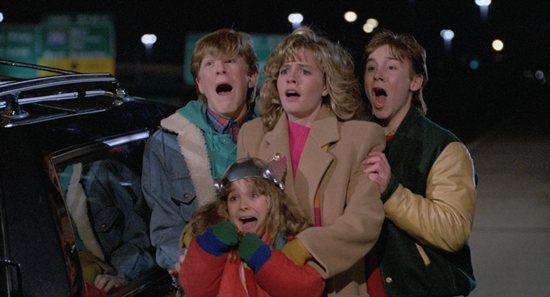
I seriously waffled on whether Adventures in Babysitting would belong on the list for issues of authenticity—the whole story revolves around Elizabeth Shue’s babysitter character adventuring through Chicago with the group of kids she needs to keep safe, but there’s a catch: Much of it was actually filmed in Toronto, Hollywood’s favorite “fill-in for any other large city” location. Still, it’s hard to deny Adventures in Babysitting in the end, both for being an ’80s family classic but especially for one of the climactic scenes, where the young girl Sara, pursued by criminals, ends up sliding down the slanted face of Chicago’s iconic Crain Communications Building, better known as the “diamond building” or the Smurfit-Stone Building. Such an intent focus on one of the best-known buildings on the Chicago skyline helps give it a local flavor that it might otherwise be lacking.
8. Barbershop
Year: 2002
Director: Tim Story
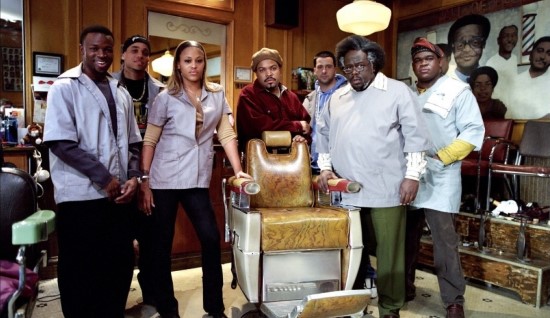
“It began as just another day on the South Side of Chicago,” intones the trailer for Barbershop in its intro, and that’s what the film manages to capture fairly well—not the glitz and glamor of the Magnificent Mile and the city’s numerous tourist attractions, but the real heart and soul of one of its many South Side urban neighborhoods and the tight-knit community that exists there. The setting of the barber shop itself is uniquely perfect for film: So ubiquitous and identifiable to any city resident that it immediately achieves an easy familiarity. It was easy to see why (primarily black) audiences embraced the film in theaters, because the humor, particularly the conversational and pop culture observational humor of Ice Cube and Cedric the Entertainer, rings so true to life. The actual plot is a fairly relaxed, lazy affair about first trying to sell and then hang on to the ownership of the barbershop, but plot isn’t really important—rather, it’s a film that evokes and pays tribute to whole Chicago communities that are so often marginalized or never seen in a positive light on the big screen. It’s a film with a lot of heart that both acknowledges the challenges and the uplifting soul of its urban setting.
9. Wayne’s World
Year: 1992
Director: Penelope Spheeris
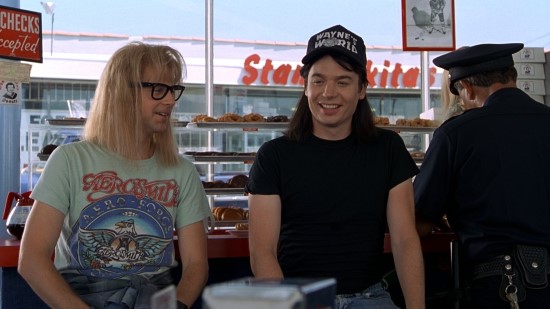
Ever since the genesis of the duo on SNL, Wayne Campbell and Garth Algar were always proud broadcasters from “Cable 10 Public Access in Aurora, Illinois,” and those Midwestern sensibilities lie at the very heart of both the sketches and the two feature films. Wayne is exactly the sort of genial, goodhearted but fairly dim everyman slacker so often lampooned in other shows of the same period based in the Midwest (most notably MST3k). He still lives in the basement of his parents’ suburban home, the big fish in an extremely small pond of local broadcasting, without any real ambitions even to expand the scope of Wayne’s World. One might actually say his lack of vision or ambition is presented as a virtue: Wayne and Garth are just simple people, happy with what they have, where Rob Lowe’s antagonist character, Benjamin, is an upwardly mobile schemer. These are exactly the roles you expect to see characters play when set in the realistic, somewhat milquetoast setting of Illinois suburbia.
10. Drinking Buddies
Year: 2013
Director: Joe Swanberg
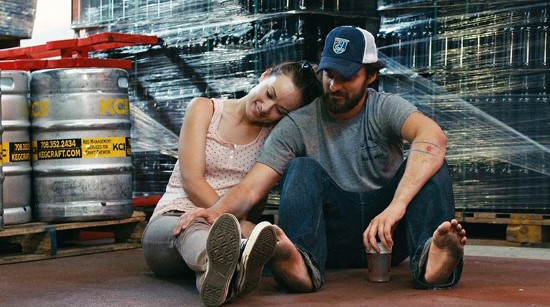
In 2013, mumblecore auteur Joe Swanberg set his sights on a slightly larger budget, but still improvisational romantic comedy/drama, and the result was Drinking Buddies, a film set primarily between characters who work together at a Chicago craft brewery. It’s a tale about modern love and the entanglements of our relationships, and how we cling to them out of duty or responsibility rather than embracing what we truly want. It feels like a very intimate, urban story, one that would no doubt feel pretty darn familiar to Chicago’s apartment dwellers, perhaps living right down the hall from the person of their dreams, but unable to ever make it happen. Is it better to go on living there, knowing that you’ll at least get some degree of contact with the object of your affection? Or move away entirely, removing the signs of your failure from daily life? Drinking Buddies is about today’s current generation of older 20-somethings and younger 30-somethings as they painfully struggle to admit to themselves how they really feel about relationships and risk some parts of themselves they’ve never been willing to risk. And it even features the most disgusting and iconic Chicago liquor of them all, Jeppson’s Malort.
11. Beginning of the End
Year: 1957
Director: Bert I. Gordon

For whatever reason, Chicago has never really been included in the “giant monster attacks” category in quite the same way as New York or Los Angeles. Perhaps it’s because there’s no ocean for the giant beast to rise out of, but the instances of the city under attack by giant radioactive monsters are few and far between, which is why we can all be thankful for Beginning of the End. Directed of course by “Mr. BIG” himself, Bert I. Gordon, who made a career out of exactly this type of picture, there’s no shortage of Illinois references, even though the mountains in the background of some scenes seem to suggest that maybe a few bits were filmed out in California. The giant locust/grasshopper monsters are heavily implied to have been born as a result of radioactive vegetable testing by my own alma mater, The University of Illinois in Urbana-Champaign, before rampaging north through the state on a collision course with Chicago. You’ve got to love the absurdly cheap effects when they get there—the primary mode of showing the monsters climbing city buildings is simply to put some locusts on a postcard of Chicago skyscrapers and then photograph it. No, seriously. Regardless, every iconic U.S. city should be trampled by monsters at least once, and this is Chicago’s shining moment in that regard.
12. Halloween
Year: 1978
Director: John Carpenter
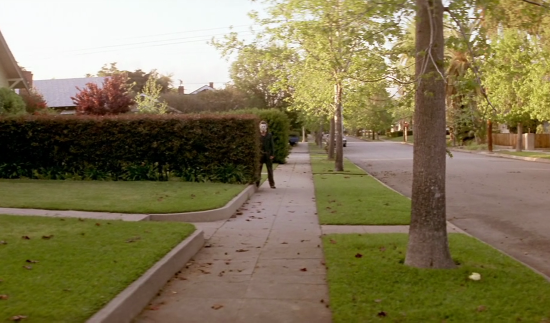
The Halloween series takes place in the fictional town of Haddonfield, Illinois, which is terrorized annually by its native boogeyman, Michael Myers. The film was actually shot in Southern California, but there’s just something about Haddonfield—it feels so spot-on to the suburban Illinois experience that I myself grew up in, right down to the cold color palette, clumped ranch houses and ever-present rustling of leaves. Halloween, likewise, was the single most influential early slasher film in its decision to bring the madness and danger HOME, to suburbia, to the very streets where so many multiplex attendees lived themselves. Before Halloween, horror films typically involved people who went off the beaten path, ending up in strange locales that they would presumably escape by film’s end. Michael Myers, on the other hand, came straight into the heart of suburbia, a silent shape entering homes in the dark and leaving a trail of bodies in his wake. This of course made Halloween a seminal fright experience for so many suburbanites, because the message is clear: You are not safe in your own home, and a white picket fence is no barrier.
13. Hoop Dreams
Year: 1994
Director: Steve James
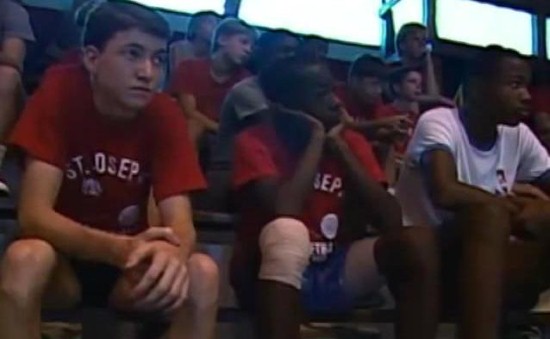
The documentary labeled by none other than Roger Ebert as the single best film of the 1990s is alternatingly beautiful and crushing, an intense profile of life in inner city Chicago and dreams of escape through basketball of all things. The story of two young men recruited by a wealthy, predominantly white high school to play basketball, it raised serious questions about modern education, race and socioeconomic status, all of which we’re still asking today. Shot over the course of five years and condensed from 250 hours of footage, it’s a sprawling story that leaves out absolutely nothing in its realistic portrayal of multiple families, yet was snubbed from a nomination in the Academy’s best documentary category, leading to public and critical outcry. It just doesn’t get any more real than this, in ways both illuminating and heartbreaking. Both of the young men profiled had older brothers gunned down in Chicago street violence in the years that followed the film’s release, one in 1994 and another in 2001. Still, interest in their story has remained strong—the restored, Criterion Collection Blu-Ray was just released for the first time this week.
14. Ferris Bueller’s Day Off
Year: 1986
Director: John Hughes

It’s sort of insane on some level to think that this is 1986, the same year as Henry: Portrait of a Serial Killer, and yet the two depictions of Chicago couldn’t possibly be more different. Indeed, the Windy City has probably never been made to look more fun and vivacious than in John Hughes classic tale of truancy, which stands in on this list for every other Hughes movie (Sixteen Candles, The Breakfast Club, Weird Science, et al), which pretty much all take place in Chicago suburbs. Bueller obviously features the city the most—the architecture and iconic sites are so important that they’re basically a supporting character, a love letter to the Second City, with Ferris as an impeccable tour guide. With that said, how they managed to go to a Cub’s game, The Art Institute, The Mercantile Exchange, fancy restaurants, The Sears Tower, a parade and get home in time before the end of a single work day is beyond me. The L simply isn’t that efficient, folks.
15. Ordinary People
Year: 1980
Director: Robert Redford

Redford’s directorial debut is set in upper-middle-class, WASP-y suburbia, the kind of place that Chicagoans derisively might picture as Lake Forest or Naperville. It’s a taut, well-acted family drama about grief and loss and mental illness—in other words, Oscar bait! And it won plenty, including Best Picture, Best Director for Redford and Best Supporting Actor for Timothy Hutton as Conrad Jarrett, the family’s youngest son, stricken with guilt over the accidental death of his older brother and his subsequent suicide attempt. It’s not exactly a pretty picture or uplifting story, but it does sound like exactly the kind of thing one would cluck over in the scandal pages of your Sunday Sun Times. It’s a wrenching drama that captures the existential malaise of stagnation and dissatisfaction in suburbia.
16. The Untouchables
Year: 1987
Director: Brian De Palma
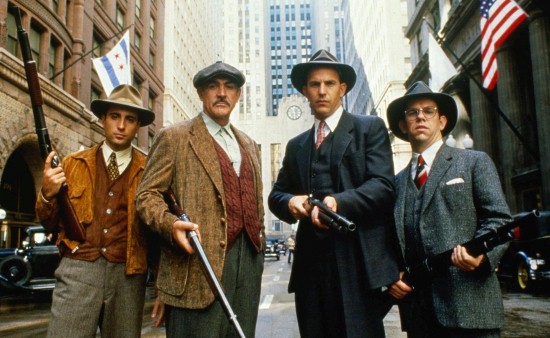
You can’t make a list like this without a few gangster movies ‘a la White Heat earlier, but among that genre there’s also got to be an Al Capone movie, and you’re really not going to beat the one with Robert De Niro playing Capone (along with Kevin Costner and Sean Connery) and a David Mamet (a Chicagoan) screenplay. A tight, fun crime drama with plenty of action, this is basically the kind of film that something like 2013’s Gangster Squad tries and fails to recapture. Connery is ultimately the most memorable star as “untouchable” and honorable beat cop Jimmy Malone, winning his only career Academy Award—and of course, his speech on taking down Capone “the Chicago way” is among the most recognizable and iconic in the history of pulpy genre filmmaking. How can you dislike it? Stuff like this is why we go to the movies. It also features instantly recognizable Chicago locations such as Union Station and the Chicago Theatre.
17. High Fidelity
Year: 2000
Director: Stephen Frears
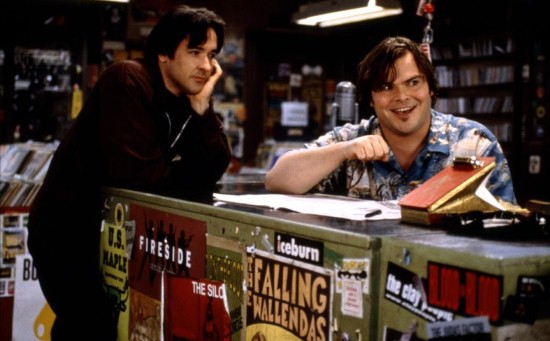
High Fidelity is like a holy text to a very small subset of the population, the perpetual “music store hangabout.” In some sense, however, given the rebirth of vinyl since the film came out in 2000, High Fidelity is almost more relevant as a story today, as the popular record stores of Chicago would attest. That is, by the way, where the story takes place—in John Cusack’s fictional Chi-town album shop “Championship Vinyl,” which could easily be filled-in by the likes of Reckless Records or say, Laurie’s Planet of Sound today. It’s also one of the better romance/comedy-dramas of its time in the way it takes on the question of responsibility and vulnerability in relationships. Cusack’s character, Rob, isn’t so much a man-child as he is a restless drifter who doesn’t even realize his nomadic style of modern dating. It’s a very modern form of self-centeredness that you can see still being explored on a weekly basis on programs such as Girls; the “I’ve got to take care of myself first” mentality that leads to characters wondering why they’re unable to build lasting relationships or really commit on an emotional level. It’s a modern portrait of singles who are undeniably adults but still have some emotional growing up to do.
18. The Blues Brothers
Year: 1980
Director: John Landis

For an intensely absurd, farcical comedy, The Blues Brothers is so much more sincere than one would ever expect it to be, both in its adoration of classic blues and R&B and the way it captured a moment in the life of the city of Chicago. Indeed, this John Landis classic lovingly shows off a Chicago that no longer exists in several instances, most notably the Maxwell Street Market, Chicago’s great open-air flea market where one could buy just about anything, legal or illegal, and also gave birth to both Chicago blues and the famed Maxwell Street Polish sausage before the city forcibly moved the market to make room for university housing among other things. It doesn’t try to put a shine on the city, showing both the high-rent (the Richard J. Daley Center) and the low (Elwood’s flophouse, numerous low-income neighborhoods) right alongside one another. This is just one of those films that completely changes the popular conception of a cityscape—if you go to Chicago, you will start picking out things from The Blues Brothers. Trying driving on Lower Wacker Drive without thinking about the Bluesmobile rocketing along and police cars smashing into one another in absurdly spectacular pile-ups. It can’t be done. It might be Chicago’s single most beloved cinematic representation.
19. Soul Food
Year: 1997
Director: George Tillman Jr.

One might almost call Soul Food the direct spiritual predecessor to Barbershop—they’re both set among large black families/communities on the South Side of Chicago, and Soul Food is directed by George Tillman Jr., who later produced on Barbershop. Of the two, though, Soul Food is more realistic and restrained, less farcical and more realistic in its depiction of family life in one of the city’s lower-income neighborhoods. It’s all about bonds of blood and how we lean on each other in hard times, even when familial feuds, jealousy and relationship issues intervene. Tillman was able to craft a picture of family life that resonated particularly strongly by basing the film as closely as he could on his own, right down to all the little traditions and rituals that help bring people together on a regular basis, in this case a Sunday soul food dinner. Watching it will make you want to swing by Bridgeport or Canaryville to get some rib tips and hot links.
20. The Fugitive
Year: 1993
Director: Andrew Davis

The Fugitive lives and breathes Chicago as few action films ever have, but it’s a cold, bitter, wintery version of the city that Illinois residents know all too well. The Harrison Ford smash hit features his character, the wrongly accused Dr. Richard Kimble, on the run from the law all over the city as he seeks for the truth behind his wife’s murder. The settings are authentic but stay away from most of the iconic, touristy sites—one of the most memorable is the action sequence taking place on board a moving L-train as Ford confronts the “one-armed man.” There’s even some snide quips about living in Chicago in general: In one scene, a police officer remarks upon the city’s tradition of dyeing the Chicago River green every year for St. Patrick’s Day—”If they can dye the river green today, why can’t they dye it blue the other 364 days of the year?” Touché, policeman.
Jim Vorel is Paste’s news editor and a product of the Chicago suburbs. You can follow him on Twitter.